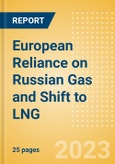The Russia-Ukraine conflict brought Europe's reliance on Russian natural gas imports to the fore. The bloc has since tried to decrease its dependance and in February 2022 committed to cutting two third of Russian natural gas imports by the end of the year. However, with a limited ability to meets its energy needs through domestic supply and dependence on Russian gas reaching 41% of total gas imports in 2020, the EU is increasingly turning to LNG in a bid to bridge its natural gas supply shortfall.
The publisher predicts that in 2030, only 38% of Europe's natural gas demand will be met by domestic supply. As a result, the bloc must seek new import partners to guarantee its energy security while decreasing its reliance on Russian natural gas. Diversification of its gas supply by increasing imports of LNG has been identified as an integral step for the bloc's energy independence. The EU, as well as individual European countries, negotiated 72 energy deals between March 2022 and January 2023. Many of the new energy deals related to natural gas and specifically LNG. For example, in March 2022, the EU and US issued a common declaration to increase LNG trade. The agreement marks an expansion of a deal negotiated in 2018, which will see the US supply 50bcm of LNG in the run up to 2030.
Due to its reliance on natural gas via pipeline, Europe currently has underdeveloped LNG infrastructure. For example, the bloc's largest economy, Germany, did not have an active LNG regasification plant before December 2022. Since then, European countries have been increasing their LNG import capacity chiefly through constructing floating LNG storage and regasification units. However, this heavy investment in LNG infrastructure may not guarantee immediate energy security. LNG terminals take 3-5 years to construct and so the bloc may still struggle to meet its demand. In addition, the investment in LNG has also raised questions about the bloc's commitment to it's decarbonization.
The publisher predicts that in 2030, only 38% of Europe's natural gas demand will be met by domestic supply. As a result, the bloc must seek new import partners to guarantee its energy security while decreasing its reliance on Russian natural gas. Diversification of its gas supply by increasing imports of LNG has been identified as an integral step for the bloc's energy independence. The EU, as well as individual European countries, negotiated 72 energy deals between March 2022 and January 2023. Many of the new energy deals related to natural gas and specifically LNG. For example, in March 2022, the EU and US issued a common declaration to increase LNG trade. The agreement marks an expansion of a deal negotiated in 2018, which will see the US supply 50bcm of LNG in the run up to 2030.
Due to its reliance on natural gas via pipeline, Europe currently has underdeveloped LNG infrastructure. For example, the bloc's largest economy, Germany, did not have an active LNG regasification plant before December 2022. Since then, European countries have been increasing their LNG import capacity chiefly through constructing floating LNG storage and regasification units. However, this heavy investment in LNG infrastructure may not guarantee immediate energy security. LNG terminals take 3-5 years to construct and so the bloc may still struggle to meet its demand. In addition, the investment in LNG has also raised questions about the bloc's commitment to it's decarbonization.
Scope
- European dependence on Russian gas, European policy response to the Russia-Ukraine conflict, Europe's shift to LNG
Reasons to Buy
- Obtain the most up to date information on recent developments and policies about Europe's reliance on Russian gas and its LNG adoption
- Identify opportunities in upcoming projects involving LNG infrastructure in Europe
- Assess the landscape of European countries' dependency on Russian gas important and LNG import capacity
- Develop business strategies by identifying the most promising sectors for future growth
Table of Contents
- Executive summary
- A timeline of increasing reliance on Russian gas
- The European gas market
- EU natural gas imports over time
- EU reliance on Russian gas imports
- Russian gas reliance by country
- IEA’s Plan
- Repower EU Plan
- European energy deals in the wake of the Ukraine conflict
- Natural gas deals by import country
- Natural gas deals by partner country
- Challenges of shifting to LNG
- LNG imports to EU and main importers over time
- EU LNG deal activity since Ukraine’s invasion
- Leading European countries by regasification capacity
- Case studies: How Germany plans to use LNG to balance energy security and decarbonization
- Contact the Publisher
- Recent EU LNG deals
- Map of natural gas pipelines and LNG carriers in Europe
- European gas market, 2015-2030
- EU’s natural gas imports relative to domestic production
- Key suppliers of EU natural gas imports
- EU reliance on Russian gas imports over time, 2015 - 2021
- Dependence on Russian gas imports in 2020 by country
- EU transnational deals by fuel type, March 2022 - January 2023
- Deals by individual European countries by fuel type, March 2022 - January 2023
- European natural gas deals by EU country, March 2022 - January 2023
- LNG imports to the European Union and main partner countries, 2015 - 2021
- Top five European countries by regasification capacity
- Map of active and planned LNG infrastructure projects in Europe
Companies Mentioned (Partial List)
A selection of companies mentioned in this report includes, but is not limited to:
- OMV
- ADNOC
- Gasgrid Finland Oy
- Excelerate Energy
- Uniper
- Open Grid Europe
- Gaunsie
- RWE








